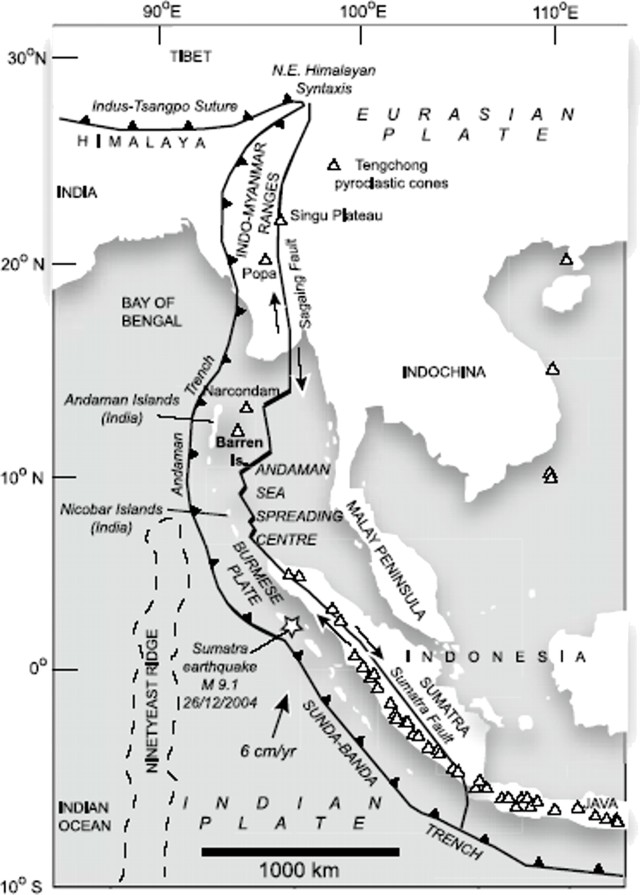Report on Barren Island (India) — March 2011
Bulletin of the Global Volcanism Network, vol. 36, no. 3 (March 2011)
Managing Editor: Richard Wunderman.
Barren Island (India) Lava takes new path to shore by 30 March 2009; ongoing (2011) thermal alerts
Please cite this report as:
Global Volcanism Program, 2011. Report on Barren Island (India) (Wunderman, R., ed.). Bulletin of the Global Volcanism Network, 36:3. Smithsonian Institution. https://doi.org/10.5479/si.GVP.BGVN201103-260010
Barren Island
India
12.278°N, 93.858°E; summit elev. 354 m
All times are local (unless otherwise noted)
Sheth and others (2009) and reports of the Geological Survey of India (e.g., GSI, 2009) present many new field observations about Barren Island's volcanism, particularly during the years 2005-2009. Although historically lava had flowed out of the caldera towards the W, Sheth and others (2009) noted that by 30 March 2009 a new channelized 'a'a lava flow had overtaken the N caldera wall. The escaping lava had arrived at the sea along the island's NNW coast and began to form a delta there.
Barren Island is a young and growing mafic, island-arc volcano in the Andaman Sea (figure 15). It produced its first historically recorded eruption in 1787 and a series of eruptions followed in later years, including pulsating activity in the past few decades. Our last report on Barren Island (BGVN 35:01) reported occasional ash plumes and decreasing thermal alerts through January 2010. When searched in mid-April 2011, the Darwin Volcanic Ash Advisory Center reported on Barren Island plumes as late as April 2010, with an unconfirmed pilot report in July 2010. A search of MODVOLC-based satellite thermal alerts found they extended through 2010 and into 2011.
 |
Figure 15. Map showing the location of Barren Island as part the N-trending volcanic arc extending between Burma (Myanmar) and Sumatra, Indonesia. Taken from Sheth and others (2009). |
2009 visit. At the end of their paper, Sheth and others (2009) inserted a 'note added in proof' describing an ongoing eruption witnessed first hand on 30 March 2009. We present that note here (with minor omissions, and broken into several paragraphs).
"We would like to report a confirmed, ongoing, lava eruption on Barren Island. The first four authors of this paper and Neeraj Awasthi visited Barren Island yet again, on 30th March 2009, on board the Indian Coast Guard vessel the ICGS Bhikaiji Cama (Captain: Commandant M. Bhatia). The volcano's central cinder cone was continuously emitting dark ash clouds every few seconds from its central crater (reminiscent of the activity in 2007 . . .), and these clouds were expanding and getting deflected towards the S. The pre-existing valley between the cinder cone and the northern caldera wall has been filled up by deposition of new ash in the past year, which has enabled the new, active lava flow to completely abandon the westerly route (taken by all historic and recent lava flows) and to reach the sea over the northern caldera wall.
"This [active] lava flow is not ensuing from the summit crater, but apparently from an intermediate elevation on the cinder cone, though details were hard to distinguish given the distance of the ship from the island. The new, channelized lava flow is currently descending at a steep angle over the northern caldera wall's outer cliff face, and into the sea. Incandescent lava is seen at a few places in it, particularly in the dark. A sizeable steam plume is currently rising from the sea where this new lava flow is entering the sea. The new lava flow has built a structure resembling an alluvial fan along the shore.
"We were able to reach this fan by using a Gemini (inflatable rubber boat) from the ship, carefully circumventing the steam plume and through seawater which was very hot (an estimated ~60-70°C). We could also collect lava samples from the southern edge of this "fan", which are typical clinkery as basalt in hand specimen. A full account of this eruption with photographs and petrological study of the rock will be attempted separately. An interesting possibility is that, were this activity to continue, the new embryonic lava delta will grow thicker and laterally, and merge with the existing lava delta on the western side of the volcano.... In summary, Barren Island is evidently a very active volcano, meriting close study."
References. GSI, 2009, The Barren Island Volcano, Explosive Strombolian type eruption observed during January 2009; Geological Survey of India — Kolkata; Jan 2009 URL: http://www.portal.gsi.gov.in/gsiImages/information/N_BarrenJan09Note.pdf).
Sheth, HC, Ray, JS, Bhutani, R, Kumar, A, and Smitha, RS, 2009, Volcanology and Eruptive Styles of Barren Island: An Active Mafic Stratovolcano in the Andaman Sea, NE Indian Ocean, Bull Volcanol (Apr 2009) 71:1021-1039, DOI: 10.1007/s00445-009-0280-z.
Geological Summary. Barren Island, a possession of India in the Andaman Sea about 135 km NE of Port Blair in the Andaman Islands, is the only historically active volcano along the N-S volcanic arc extending between Sumatra and Burma (Myanmar). It is the emergent summit of a volcano that rises from a depth of about 2250 m. The small, uninhabited 3-km-wide island contains a roughly 2-km-wide caldera with walls 250-350 m high. The caldera, which is open to the sea on the west, was created during a major explosive eruption in the late Pleistocene that produced pyroclastic-flow and -surge deposits. Historical eruptions have changed the morphology of the pyroclastic cone in the center of the caldera, and lava flows that fill much of the caldera floor have reached the sea along the western coast.
Information Contacts: Darwin Volcanic Ash Advisory Centre (VAAC), Bureau of Meteorology, Northern Territory Regional Office, PO Box 40050, Casuarina, NT 0811, Australia (URL: http://www.bom.gov.au/info/vaac/); Hawai'i Institute of Geophysics and Planetology (HIGP) MODVOLC Thermal Alerts System, School of Ocean and Earth Science and Technology (SOEST), Univ. of Hawai'i, 2525 Correa Road, Honolulu, HI 96822, USA (URL: http://modis.higp.hawaii.edu/).

